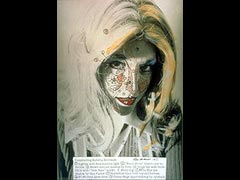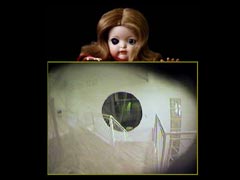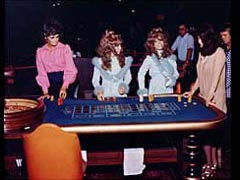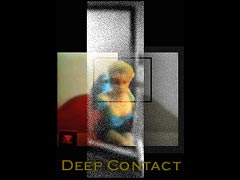| http://www.lynnhershman.com |
 |
|||
| |
| Reconstructing and deconstructing identities is Lynn Hershman’s artistic obsession. The main female figures in her performances, videos, films, photographs, interactive installations and networked projects don't, though, have coherent identities--they are shifting personalities. They often suffer from borderline syndromes, the primary logic of which presupposes the nonexistence of borders between different levels of reality. "Roberta Breitmore," a portrait-performance created by Lynn Hershman in the mid-70s, finds herself in this state. Roberta is a 30-year-old divorcee who, with her $1800 savings, moves from Cleveland Heights to San Francisco in 1975. Bad luck follows her around; she's neurotic and mostly behaves awkwardly. Like all the other female protagonists in Hershman's work, Roberta symbolizes the archetypal female city dweller. She takes active part in social life but, all the same, leads a lonely, anonymous, and marginal existence. If any one factor connects Lynn Hershman’s personae then it is their common failure to assume socially accepted roles or behavior patterns: Their lives are marked by unsuccessful attempts to make social contact and build stabile relationships. Female figures like Roberta, Lisa, Lorna and even Roberta's youngest reincarnation, CyberRoberta, seem recurrently driven to repeat the same fatal strategies. Underlying these character sketches is the conviction that obsession, compulsion, and abiding to rules are decisive human traits. In comparison to these, the desire for free, self-determined behavior is conceivably small. Human beings love to surround themselves with rules that free them from having to handle on their own authority. In a live performance from 1975, a robotic doll called Lady Luck plays roulette with the human actress Lisa Charles and proves that, within a set framework of rules, its more successful to trust in machine automatism than human intuition. Lady Luck takes up the classic doppelganger motif that has been used repeatedly in art over the centuries to ingeniously double reality and consider the self-image from a distanced perspective. The strategies we use to form an image of the world for ourselves and to construct our own self-images will become increasing complex with the escalating mechanization of our everyday world. Our machines are images/models of ourselves that supply us at the same time with altered identity structures to which we adapt our self-image. Today we live in a state of constant adaptation to changing realities that makes it necessary for us to continually reinvent self-images. Whilst Lady Luck was easily recognizable as Lisa Charles’s doppelganger, Roberta Breitmore seems for the moment to lead an apparently autonomous existence. She acts in everyday situations without an audience, rents a room, opens a bank account, places adds in personal columns and visits her psychiatrist. Since Roberta is alternately portrayed at different stages of her existence by Lynn Hershman and other performers, the difference between prototype and reproduction, between the artist, her (re)construction and that of the other interpreters, becomes increasingly blurred. Strictly speaking "Roberta" the artwork doesn’t exist, as she never appeared in an art context. It was first in 1978, after her exorcism, that she was represented in exhibitions by many of the remnants she left behind her in life. Checks, driving license, announcements, letters, diary, electrocardiogram, fingerprints, photos, films, video, and audio cassettes are the leftovers that, combined with Hershman’s descriptions, have given her existence a second reconstruction in an art context. At the Mandeville Art Gallery in San Diego in 1976, Hershman exhibited photos of Roberta, her psychiatric report and a hologram that showed Hershman herself getting ready to be Roberta. For many women, the everyday act of applying makeup wasn’t used in Roberta's (re)construction as a mask but rather as an aid to creating identity. In Hershman’s work, masking is an identity establishing strategy that helps to reveal the self. At the onset of the 90s, the strategy for masking changed. In interactive video installations like "Deep Contact" and "Room of One's Own" monitors and digital technology become the new masks and, therefore, identity establishing media. This change of media, which throws light on the present transformation of our culture, is also linked to persona role changes. In place of the shy, neurotic, and uneasy woman personified by Roberta, appears the offensive, shorthaired Marion, who attacks the viewer from the monitor screen. She becomes an object of male attention but, by the same token, makes the viewer understand that he, with his own eyes, is the one creating reality. Here, the artwork no longer exclusively manifests the artist's intent such as in Roberta's reconstruction, but rather, it is a projection of the viewer's imagination. As the protagonist in the interactive installations and performer in the "Phantom Limb" photographs, Marion personifies the defender of a vulnerable private sphere who, through the immediacy of technical image devices, is facing a new kind of threat. Similar to in "Dante Hotel", a site-specific work by Hershman from 1973 in which the visitors come across two women in a rumpled hotel bed and, subsequently, become their inadvertent clients, the visitors looking through the periscope at Marion's miniature room in "Room of One's Own" become the voyeurs of an intimate scene. Contained in the moment of every masking that Hershman outlines is the possibility or freedom for self-determined actions. This is similarly true of Roberta's reincarnation as CyberRoberta in 1998. CyberRoberta is a cybernetic doll that watches real space through her camera eyes and transfers her observations to the world of the Internet. She lives in two worlds simultaneously. Roberta the Cyborg is, on one hand, the omnipotent surveyor that controls the event and, on the other, the re-embodiment of the actual controllers, the Internet users operating invisibly and anonymously. She personifies what we recognize today as multiple realities - a coexistence of different levels of reality that are organized like a kaleidoscope. The various facets don't differentiate fundamentally from one another. Their deciding characteristic is the circumstance that they are subject to constant reorganization. The Internet is just as much a space as real space is; it is simultaneously open to all and closed to all, a world without an overview that is only perceptible from each individual's personal perspective. Internet communication demands a re-embodied body language and sets up the conditions for (re) constructing multiple identities that can continually change their manifestations and adapt to new conditions. The model underlying CyberRoberta’s identity-establishing mask is no longer the painted image as in Roberta’s case; it is a network of changing relationships, intensities and energies that have new manifestations in each moment of every participant’s actions. 1. see XLII Esposizione internationale d'arte. Arte e Alchemia, La Biennale di Venezia, Venecia 1986, pp. 78, 118, 263. See also Lynn Hershman: Die Romantiserung des Antikörpers, please put in the correct title in: Catalogue: Ich ist etwas Anderes. Kunst am Ende des 20. Jahrhunderts, (The Self is Some Other. Art at the End of the 20th Century), Kunstsammlung Nordrhein-Westfalen, Duesseldorf 2000, pp. 61-64. 2. for a comprehensive interpretation of Hershman's interactive work see the authors book Pioniere Interaktiver Kunst. Von 1970 bis heute (Pioneers of Interactive Art. From 1970 to the Present), Edition ZKM, Center for Art and Media Technology Karlsruhe, Ostfildern 1997, pp. 170-195. 3. for an analysis of the strategies of re-embodiment in Interactive Art see the authors forthcoming article: Das Flottierende Werk. Zum Entstehen einer neuen künstlerischen Organisationsform (The Floating Work of Art, Considerations on the establishment of a New Form of Artistic Organisation), in: Anschluss - Einschluss - Teilnahme. Formen interaktiver Medienkunst, (Connection - Inclusion - Participation), ed. by Natalie Bimczek, Peter Gendolla, Peter M. Spangenberg, Frankfurt/Main, Suhrkamp 2000 (in print) Söke Dinkla is an art historian who works as a curator and critic in the fields of art, architecture, design and new media. She studied art history, literature, ethnology and biology at the universities of Kiel, Hamburg and Bielefeld. In 1990, she worked as a curator with the Siemens Cultural Programme, Munich. In 1993 she was awarded a scholarship from the Institute of Cultural Studies in Essen and, in 1994, from German Academic Exchange Programme (DAAD) in the United States of America. She received her Ph.D. from the university of Hamburg in 1996. In 1997, she was the curator of the exhibition "Inter-Act at the Wilhelm Lehmbruck Museum Duisburg and published the standard reference book "Pioneers of Interactive Art. From 1970 to the Present In 1999, she was the curator of "Connected Cities, a multilocal, networked art event at the Wilhelm Lehmbruck Museum Duisburg and different venues throughout the whole Ruhr district. Söke Dinkla has lectured at many international congresses including: 1992 XXVIII. International Congress on Art History, Berlin; 1994 International Symposium on Electronic Art (ISEA), Helsinki; 1999 Künstlerhaus Wien; V2-Organisatie, Rotterdam; Actor 2000, München, 1999 Wissenschaftsfestival, Gesellschaft für Mathematik und Datenverarbeitung, Sankt Augustin; 2000 Hochschule für Gestaltung, Karlsruhe; Literaturhaus, München. |




